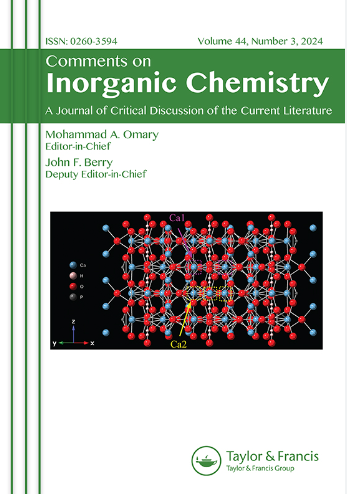用滴定法和31P-NMR光谱法测定六偏磷酸盐的结构
IF 3.8
3区 化学
Q1 CHEMISTRY, INORGANIC & NUCLEAR
引用次数: 3
摘要
六偏磷酸盐(HMP)是一种无机浓缩磷酸盐,近一个世纪以来已广泛应用于各种行业,最初的专利用于脱絮凝粘土和软化硬水。今天,HMP仍用于矿物加工工业作为分散剂,以提高分离。它也用于食品工业,作为添加剂E452i,以提高乳清蛋白饮料的稳定性,防止发酵香肠的腐臭,并作为加工奶酪的乳化盐。HMP用于一些牙膏,以防止龋齿和减少所需的氟量。HMP在这些应用中特别有用,因为它能够与表面结合,提供空间和静电排斥,并与多价阳离子形成强可溶性配合物。事实上,研究已经确定HMP是阳离子结合最有效的浓缩磷酸盐,然而,由于对HMP结构的混淆,其确切原因尚不清楚。虽然对所有这些行业都很重要,但了解HMP的结构对其新兴的生物医学应用尤为重要。这些包括生物材料配方,如水泥,控制抗生素释放的材料和纳米颗粒药物递送载体,但也使用HMP作为对抗病理性钙化的有效治疗方法,如异位骨化和肾结石。了解HMP的精确结构对于临床应用尤其重要,以便可靠和可重复地预测疗效和ADME(吸收、分布、代谢和排泄)特性,以克服监管障碍。目前关于HMP的结构有两种流行的观点。一些研究表明HMP是一个12元环(图1A),而另一些研究则认为HMP是一个线性聚磷酸盐(图1B)。也有人建议,线性和循环产品都是可用的,但都被称为HMP商业。这种混淆阻碍了一些比较研究的尝试,因为尚不清楚每个研究中使用的HMP是否相同本文章由计算机程序翻译,如有差异,请以英文原文为准。
Determining the Structure of Hexametaphosphate by Titration and 31P-NMR Spectroscopy
Hexametaphosphate (HMP) is an inorganic condensed phosphate, which has been used in a wide variety of industries for nearly a century, originally patented to deflocculate clay and soften hard water. Today, HMP is still used in the minerals processing industry as a dispersant to improve separation. It is also used in the food industry, as additive E452i, to improve the stability of whey protein drinks, prevent efflorescence in fermented sausages, and as an emulsifying salt in processed cheese. HMP is used in some toothpastes, to prevent caries and reduce the amount of fluorine required. HMP is particularly useful in these applications due to its ability to bind to surfaces to provide steric and electrostatic repulsion, and to form strong soluble complexes with multivalent cations. Indeed, studies have identified HMP as the most potent of the condensed phosphates for cation binding, however, the exact reason for this is somewhat unclear because of confusion about the structure of HMP. While important for all of these industries, understanding the structure of HMP is of particular importance for its emerging biomedical applications. These include biomaterial formulations such as cements, materials for controlled antibiotic release and nanoparticulate drug delivery vehicles, but also using HMP as the active therapeutic to combat pathological calcifications, such as heterotopic ossification and kidney stones. It is particularly important to know the precise structure of HMP for clinical applications in order to reliably and reproducibly predict efficacy and ADME (absorption, distribution, metabolism and excretion) properties, to overcome regulatory hurdles. There are currently two popular ideas for the structure of HMP. Some studies state that HMP is a 12 membered ring (Figure 1A), while others claim HMP is a linear polyphosphate (Figure 1B). It has also been suggested that both linear and cyclic products are available, but are both referred to as HMP commercially. This confusion has prevented some attempts to compare between studies, because it is not clear whether the HMP used in each is the
求助全文
通过发布文献求助,成功后即可免费获取论文全文。
去求助
来源期刊

Comments on Inorganic Chemistry
化学-无机化学与核化学
CiteScore
9.00
自引率
1.90%
发文量
18
审稿时长
>12 weeks
期刊介绍:
Comments on Inorganic Chemistry is intended as a vehicle for authoritatively written critical discussions of inorganic chemistry research. We publish focused articles of any length that critique or comment upon new concepts, or which introduce new interpretations or developments of long-standing concepts. “Comments” may contain critical discussions of previously published work, or original research that critiques existing concepts or introduces novel concepts.
Through the medium of “comments,” the Editors encourage authors in any area of inorganic chemistry - synthesis, structure, spectroscopy, kinetics and mechanisms, theory - to write about their interests in a manner that is both personal and pedagogical. Comments is an excellent platform for younger inorganic chemists whose research is not yet widely known to describe their work, and add to the spectrum of Comments’ author profiles, which includes many well-established inorganic chemists.
 求助内容:
求助内容: 应助结果提醒方式:
应助结果提醒方式:


